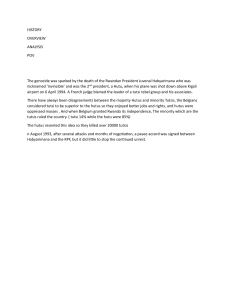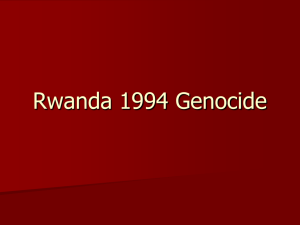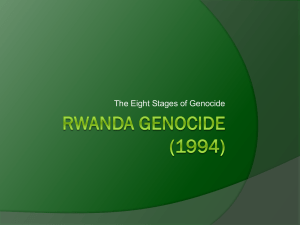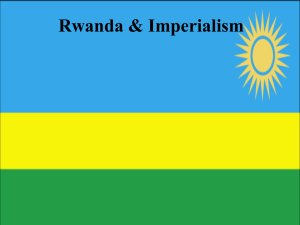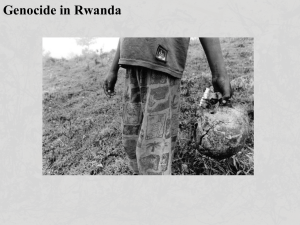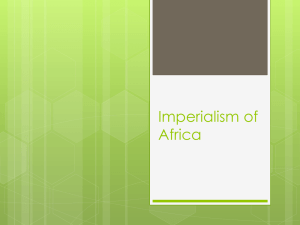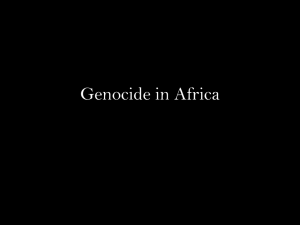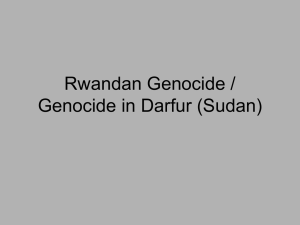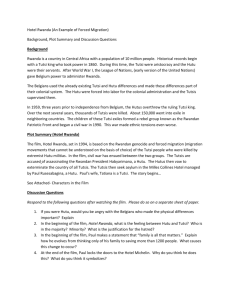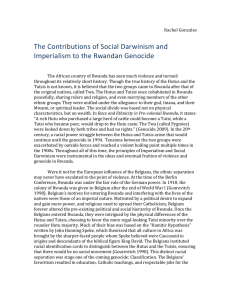Rwandan
advertisement
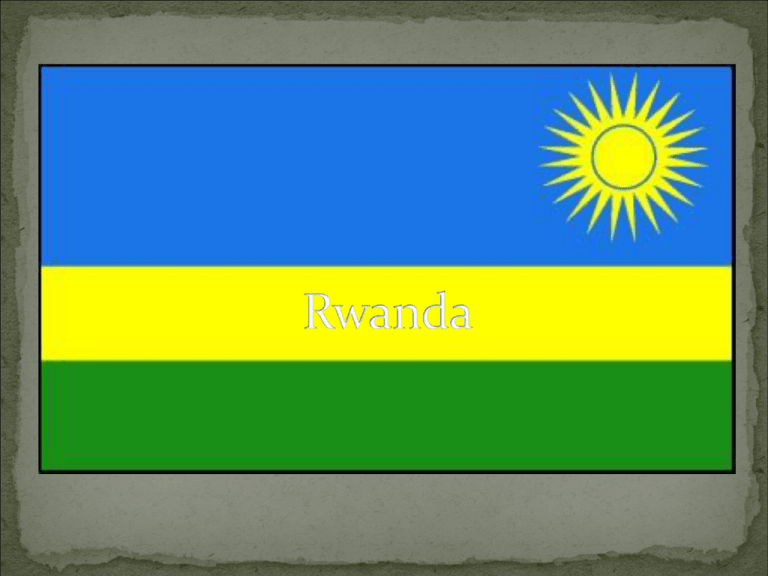
Located in East- Central Africa Landlocked, but located on Lake Kivu Well known for its lush countryside and arable land Hutu population first arrived from Congo in the 10th Century (900s) Tutsis arrived in the 15th Century and conquered the Hutus (1400s) Tutsis created a feudal system Hutus became serfs Tutsis maintained their superiority and feudal system until the arrival of the Europeans in the 19th Century (1800s) The difference between the two would come to focus on wealth, determined by number cows Traders first arrived in 1858 Germans arrived in 1890 after the Berlin Conference The Mwami, or Tutsi kings, accepted Germans without a fight Germans ruled the territory until 1918 Belgians appointed as the protector by the League of Nations The Tutsi kings were allowed to continue to rule Tutsis represented only 15% of the population Only Tutsi males were educated Coffee was established as a cash crop ID cards were required to be carried at all times Made it impossible to change from Hutu to Tutsi based on wealthy Hutu resistance was violently suppressed – amputation was a standard punishment Hutus began speaking out against inequalities in the 1950s The death of the king prompted many Hutus to rebel Hutus began fighting against Tutsis throughout the country Hutus successfully overthrew the government and gained control Beginnings of independence 1960 – Elections were held after the Hutu Revolution Gregoire Kayibanda was elected Prime Minister 1961 – Parliament abolished the Tutsi monarchy and declared Rwanda to be a republic July 1, 1962 – Belgium is pressured by the UN to grant Rwanda its independence Kayibanda served as President and was re-elected in ‘65 and ‘69 1964 – Exiled Tutsis invade Rwanda and attempt coup Hutu army defeats rebels and respond by killing Tutsis 1973 – President Kayibanda is overthrow in a military coup by Juvenal Habyarimana Habyarimana operates as a dictator 1990 –Rwandan Patriotic Front, led by Paul Kagame (Tutsi), attacks to gain control of the government 1993 – UN brokers a deal to share power between the two and peacekeepers are sent to Rwanda Directions: With a partner, brainstorm the answers to the following questions: 1. What is the historical relationship between the Hutus and the Tutsis? 2. What in Rwanda’s history could have contributed to the genocide? 3. What event do you think was the most influential in the years before the genocide? April 1994 – President Habyarimana’s plane is shot down Systematic killing of Tutsis and moderate Hutus begins immediately Rwandan Patriotic Front begins to fight against Hutu Army Country dissolves into civil war Hutus flee Rwanda for neighboring Burundi and the Congo http://www.millecollines.net/ Paul Kagame preparing to vote UN troops remained until 1996 Tutsis and Hutus continued to fight over the borders of the Democratic Republic of the Congo and Uganda May 2003 – A new constitution was ratified August 2003 – RPF leader Paul Kagame is elected president of Rwanda Kagame has been accused of censoring opposition 2008 GDP Per Capita = $427 64% literacy rate The average student is in school until the age of 9 Average primary school has 66 students for every teacher 17% urban population, 83% rural 2.1% population growth rate per year Average life expectancy =41 years of age Doctors = 1 per 10,000 people Directions: With a partner, brainstorm the answers to the following questions 1. Is Rwanda Developed, Developing, or Least Developed? 2. How has Rwanda’s history affected its current status? 3. What is the biggest problem facing Rwanda today? With a partner/small group: Identify at least 2 problems that Rwanda has suffered as a result of imperialism – Be sure to identify how it is connected to imperialism!
